KI M Đ NH CÁC GI Ể Ị Ả THUY T TH NG KÊ V CÁC H S H I QUI Ề Ệ Ố Ồ Ố Ế
Mô hình:
b
H
Y = b1 + b2X + u b = 2
0 :
0 2
Gi
ả
thuy t Ho: ế
b
b
„
H
1 :
2
0 2
Gi
ả
thuy t H1 ế
ể đị
ế
ẽ
ả
ả
ậ
tin c y 5% và 1%
ớ độ ạ ố
đị
ủ
ũ
ĩ
ĩ
Ở đ ây chúng ta s mô t ki m nh gi thuy t v i ứ m c ý ngh a. Nó c ng xác nh ý ngh a c a sai s lo i I là gì.
Ệ Ố Ồ
Ể ĐỊ
Ả
Ế
Ề
Ố KI M NH CÁC GI THUY T TH NG KÊ V CÁC H S H I QUI
Mô hình:
Y = b
H
0 :
1 + b b = b 2
2X + u 0 2
Gi
ả
thuy t H0: ế
b
b
„
H
1 :
2
0 2
Gi
ả
thuy t H1 ế
ẩ
n chu n và chúng
ồ ệ ố ồ
ả ử ằ ả
ằ
đơ ằ
ộ
ị
gi thuy t
ẽ ể đ nhị
H0 r ng h s h i qui b ng m t giá tr nào
Chúng ta s gi s r ng chúng ta có mô hình h i qui ế ố ta mu n ki m ủ b đ ó c a
0. 2
2
Ể ĐỊ Ệ Ố Ồ Ố Ả Ế Ề KI M NH CÁC G I THUY T TH NG KÊ V CÁC H S H I QUI
Mô hình:
Y = b
H
0 :
1 + b b = b 2
2X + u 0 2
Gi
ả
thuy t Ho: ế
b
b
„
H
1 :
2
0 2
Gi
ả
thuy t H1 ế
ả
ả
ả
c mô t nh gi thuy t Ho
ị
ể đị ả
. Chúng ta s ẽ ỉ ằ
đượ ế
ư ả
ế
Gi thuy t ki m ể đ nh
ế đượ ượ ng
c ki m nh c v i gi thuy t Ho là gi thuy t
ế b H1, nó ám ch r ng
2
ằ
ớ ị b không b ng giá tr
0. 2
3
Ể ĐỊ Ệ Ố Ồ Ố Ả Ế Ề KI M NH CÁC G I THUY T TH NG KÊ V CÁC H S H I QUI
Mô hình:
Y = b
H
0 :
1 + b b = b 2
2X + u 0 2
Gi
thuy t:
ả
ế
b
b
„
H
1 :
2
0 2
Gi
ả
thuy t H1 ế
Mô hình ví d :ụ
2w + u 0.1
2
0
Gi
ả
thuy t Ho: ế
„
1 + b p = b =bH : bH :
0.1
2
1
Gi
ả
thuy t H1: ế
ọ
ư
ẽ
đế
ủ
ươ
đế
ủ
ề
ạ
ả
ạ n l m phát c a ỷ ệ ă
ủ
n l m phát c a ti n l
ng.
p là t l t ng c a giá
ủ
Nh minh h a, chúng ta s xem xét mô hình liên quan giá c kiên quan ỷ ệ ă và w là t l t ng c a l
ươ . ng
4
Ể ĐỊ Ệ Ố Ồ Ố Ả Ế Ề KI M NH CÁC G I THUY T TH NG KÊ V CÁC H S H I QUI
Mô hình:
Y = b
H
0 :
1 + b b = b 2
2X + u 0 2
Gi
ả
thuy t H0: ế
b
b
„
H
1 :
2
0 2
Gi
ả
thuy t H1 ế
Mô hình ví d :ụ
2w + u 0.1
2
0
Gi
ả
thuy t H0: ế
„
1 + b p = b =bH : bH :
0.1
2
1
G i thuy t H1:
ế
ả
ẽ
ể đị
ớ
ằ
ằ
ă
ế ế
ả ả
ế
ỷ ệ ă ng. Gi thuy t Ho vì th là
ỷ ệ 2 = 1.0. (Chúng ta
ủ H0: b
ể đị
Chúng ta s ki m nh gi thuy t r ng t l t ng c a giá b ng v i t l ề ươ ủ t ng c a ti nl b nên ki m nh
1 = 0.)
5
Ể ĐỊ Ệ Ố Ồ Ố Ả Ế Ề KI M NH CÁC G I THUY T TH NG KÊ V CÁC H S H I QUI
xác
ấ Hàm m t su t c a ậ độ ủ b2
b2 d
ế ẩ
ướ ủ 2 =1.0 là úng ( ư đượ đư ố Phân ph i c a H0: b đ ằ b ng 0.1 nh ả i gi thuy t độ ệ l ch chu n a ra) c
0.6
0.7
0.8
0.9
1.0 1.1
1.2
1.3
1.4
b2
ế
đ
ẽ
ằ
ớ b2 s có phân ph i v i trung bình b ng 1.
N u H0 úng , h s h i qui ố Để ẽ
ệ ố ồ ủ
ả
ủ
ế độ ệ
v phân ph i c a nó chúng ta ph i bi t
ố ẩ l ch chu n c a nó
6
Ể ĐỊ Ệ Ố Ồ Ố Ả Ề Ế KI M NH CÁC G I THUY T TH NG KÊ V CÁC H S H I QUI
xác
ấ Hàm m t su t c a ậ độ ủ b2
b2 d
ế ẩ
ướ ủ 2 =1.0 là úng ( ư đượ đư ố Phân ph i c a H0: b đ ằ b ng 0.1 nh ả i gi thuy t độ ệ l ch chu n a ra) c
0.6
0.7
0.8
0.9
1.0 1.1
1.2
1.3
1.4
b2
Đ ề
ă
ẩ
ằ
0.1. i u úng ta bi t d l ch chu n và nó b ng ự
ế
ế
ế ả đị Chúng ta gi nh r ng ch ự này không th c t và chúng ta có th
ượng chúng trong th c t .
ộ ệ ể ư c lớ
7
Ể ĐỊ Ệ Ố Ồ Ố Ả Ề Ế KI M NH CÁC G I THUY T TH NG KÊ V CÁC H S H I QUI
xác
ấ Hàm m t su t c a ậ độ ủ b2
b2 d
ế ẩ
ướ ủ 2 =1.0 là úng ( ư đượ đư ố Phân ph i c a H0: b đ 0 ằ b ng 0.1 nh ả i gi thuy t độ ệ l ch chu n a ra) c
b b b b b b b b2
2sd 0
0 2
2+s 0
2+4s 0
2 0 4sd
2 0 3sd
2 0 2sd
d d b 2+2s 0 d b 2+3s 0 d
ủ
ữ
ợ
ộ
ầ
là phân ph i c a ằ
ườ ế độ ệ
đị
ố ây Đ b2 cho tr ta gi iả nh r ng chúng ta bi t
ổ ng h p t ng quát. M t l n n a, chúng ẩ l ch chu n(sd).
8
Ể ĐỊ Ệ Ố Ồ Ố Ả Ế Ề KI M NH CÁC G I THUY T TH NG KÊ V CÁC H S H I QUI
xác
ấ Hàm m t su t c a ậ độ ủ b2
b2 d
ế ẩ
ướ ủ 2 =1.0 là úng ( ư đượ đư ố Phân ph i c a H0: b đ ằ b ng 0.1 nh ả i gi thuy t độ ệ l ch chu n a ra) c
0.6
0.7
0.8
0.9
1.0 1.1
1.2
1.3
1.4
b2
ố
ạ
ạ
ề
ệ ố
Đ ề
ươ
ượ
ng và các
ệ ả ử ằ chúng ta có m u các s li u cho mô hình l m phát giá và l m b2, là 0.9. i u này có
Gi s r ng phát ti n l ứ đủ
ứ để
ạ
ả
ẫ ướ c l ố
ch ng c
chúng ta ch ng l i gi thuy t
ng cho h s góc ế b
= 1.0 hay không?
2
9
Ể ĐỊ Ệ Ố Ồ Ố Ả Ề Ế KI M NH CÁC G I THUY T TH NG KÊ V CÁC H S H I QUI
xác
ấ Hàm m t su t c a ậ độ ủ b2
b2 d
ế ẩ
ướ ủ 2 =1.0 là úng ( ư đượ đư ố Phân ph i c a H0: b đ ằ b ng 0.1 nh ả i gi thuy t độ ệ l ch chu n a ra) c
0.6
0.7
0.8
0.9
1.0 1.1
1.2
1.3
1.4
b2
ỏ ơ
ể
ư
ở
ẫ
ị 1.0 nh ng b i vì có y u t ng u
ố
ế
ể
ố ế đượ ướ c c
ượ
đ
ằ
ị
Không, nó không th . Nó nh h n giá tr nhiên trông mô hình vì th chúng ta không th mong mu n có 1.0. l
ng b ng úng giá tr là
10
Ể ĐỊ Ệ Ố Ồ Ố Ả Ề Ế KI M NH CÁC G I THUY T TH NG KÊ V CÁC H S H I QUI
xác
ấ Hàm m t su t c a ậ độ ủ b2
b2 d
ế ẩ
ướ ủ 2 =1.0 là úng ( ư đượ đư ố Phân ph i c a H0: b đ ằ b ng 0.1 nh ả i gi thuy t độ ệ l ch chu n a ra) c
0.6
0.7
0.8
0.9
1.0 1.1
1.2
1.3
1.4
b2
ả
ườ
đ
ể
ế
đượ ướ c
c
ng xuyên có ế ự
ế
ẩ
ế ượ
N u gi thuy t Ho là úng, chúng ta có th th l
ỏ ằ 0.9, vì th không có mâu thu n th c t nào
ng nh b ng
.
11
Ể ĐỊ Ệ Ố Ồ Ố Ả Ề Ế KI M NH CÁC G I THUY T TH NG KÊ V CÁC H S H I QUI
xác
ấ Hàm m t su t c a ậ độ ủ b2
b2 d
ế ẩ
ướ ủ 2 =1.0 là úng ( ư đượ đư ố Phân ph i c a H0: b đ 0 ằ b ng 0.1 nh ả i gi thuy t độ ệ l ch chu n a ra) c
b b b b b b b b2
2sd 0
0 2
2+s 0
2+4s 0
2 0 4sd
2 0 3sd
2 0 2sd
d d b 2+2s 0 d b 2+3s 0 d
ợ
ướ
ượ
ộ độ ệ
ơ
ấ
ẩ
c l
ng th p h n m t
l ch chu n so
ớ
Trong tr v i giá tr theo gi thuy t
ổ ườ ng h p t ng quát, ế . ả ị
12
Ể ĐỊ Ệ Ố Ồ Ố Ả Ế Ề KI M NH CÁC G I THUY T TH NG KÊ V CÁC H S H I QUI
xác
ấ Hàm m t su t c a ậ độ ủ b2
b2 d
ế ẩ
ướ ủ 2 =1.0 là úng ( ư đượ đư ố Phân ph i c a H0: b đ 0 ằ b ng 0.1 nh ả i gi thuy t độ ệ l ch chu n a ra) c
b b b b b b b b2
2sd 0
0 2
2+s 0
2+4s 0
2 0 4sd
2 0 3sd
2 0 2sd
d d b 2+2s 0 d b 2+3s 0 d
ả
ướ
ượ
đ
ấ
có
c l
ơ ng th p h n hay cao
ế ơ
ớ
ẩ
ế N u gi thuy t Ho là úng ộ độ ệ h n m t
ấ để , xác su t ị l ch chu n so v i giá tr trung bình là
31.7%.
13
Ể ĐỊ Ệ Ố Ồ Ố Ả Ề Ế KI M NH CÁC G I THUY T TH NG KÊ V CÁC H S H I QUI
xác
ấ Hàm m t su t c a ậ độ ủ b2
b2 d
ế ẩ
ướ ủ 2 =1.0 là úng ( ư đượ đư ố Phân ph i c a H0: b đ ằ b ng 0.1 nh ả i gi thuy t độ ệ l ch chu n a ra) c
0.6
0.7
0.8
0.9
1.0 1.1
1.2
1.3
1.4
b2
ả
ờ
ử ằ
ạ
ạ
ị ướ
ả Đ ề
ề ẩ
ượ
ớ
ẽ
ng, chúng ta có giá tr
. i u này s mâu thu n v i
ng là 1.4
c l
ươ ả
ế
Bây gi g i s r ng trong mô hình l m phát giá c và l m phát ti n l gi thi t Ho
.
14
Ể ĐỊ Ệ Ố Ồ Ố Ả Ế Ề KI M NH CÁC G I THUY T TH NG KÊ V CÁC H S H I QUI
xác
ấ Hàm m t su t c a ậ độ ủ b2
b2 d
ế ẩ
ướ ủ 2 =1.0 là úng ( ư đượ đư ố Phân ph i c a H0: b đ 0 ằ b ng 0.1 nh ả i gi thuy t độ ệ l ch chu n a ra) c
b b b b b b b b2
2sd 0
0 2
2+s 0
2+4s 0
2 0 4sd
2 0 3sd
2 0 2sd
d d b 2+2s 0 d b 2+3s 0 d
ớ
ầ độ ệ
ớ
ố
ẩ
ơ ộ để
ị ướ
ư
ế
ả
ỉ
l ch chu n so cao h n so v i trung bình theo 0.006%.
có giá tr ỏ
c l ế
ế
ả
ơ ơ 1.4 l n h n b n l n ế ượ ng nh th ch có gi thuy t và c h i ể . Chúng ta vì th có th bác b gi thi t Ho
15
Ể ĐỊ Ệ Ố Ồ Ố Ả Ế Ề KI M NH CÁC G I THUY T TH NG KÊ V CÁC H S H I QUI
xác
ấ Hàm m t su t c a ậ độ ủ b2
b2 d
ế ẩ
ướ ủ 2 =1.0 là úng ( ư đượ đư ố Phân ph i c a H0: b đ ằ b ng 0.1 nh ả i gi thuy t độ ệ l ch chu n a ra) c
0.6
0.7
0.8
0.9
1.0 1.1
1.2
1.3
1.4
b2
ạ
ả
ạ
ả ử ớ ượ
ề ượ
ả ướ
Đ
ộ
ế
ờ Bây gi gi s v i mô hình l m phát giá c và l m phát ti n l ị ướ giá tr
0.77. ây là m t k t qu
ẫ ng m u là
ươ ng t i
ng và ồ .
c l
c l
16
Ể ĐỊ Ệ Ố Ồ Ố Ả Ế Ề KI M NH CÁC G I THUY T TH NG KÊ V CÁC H S H I QUI
xác
ấ Hàm m t su t c a ậ độ ủ b2
b2 d
ế ẩ
ướ ủ 2 =1.0 là úng ( ư đượ đư ố Phân ph i c a H0: b đ 0 ằ b ng 0.1 nh ả i gi thuy t độ ệ l ch chu n a ra) c
b b b b b b b b2
2sd 0
0 2
2+s 0
2+4s 0
2 0 4sd
2 0 3sd
2 0 2sd
d d b 2+2s 0 d b 2+3s 0 d
ướ
ế
ả
ị ủ
ướ
ằ
ả
i gi thi t Ho, giá tr c a các
c l
ữ 2
ị
độ ệ
ẩ
ướ
D và 3
ượ i giá tr trung bình
ng n m trong kho ng gi a .
l ch chu n d
17
Ể ĐỊ Ệ Ố Ồ Ố Ả Ế Ề KI M NH CÁC G I THUY T TH NG KÊ V CÁC H S H I QUI
xác
ấ Hàm m t su t c a ậ độ ủ b2
b2 d
ế ẩ
ướ ủ 2 =1.0 là úng ( ư đượ đư ố Phân ph i c a H0: b đ ằ b ng 0.1 nh ả i gi thuy t độ ệ l ch chu n a ra) c
0.6
0.7
0.8
0.9
1.0 1.1
1.2
1.3
1.4
b2
đ
ộ
ả
ướ
c tính
ế ả ă . M t là gi thi t Ho úng và chúng ta có ự
ự
Có hai kh n ng không th c s chính xác
18
Ể ĐỊ Ệ Ố Ồ Ố Ả Ế Ề KI M NH CÁC G I THUY T TH NG KÊ V CÁC H S H I QUI
xác
ấ Hàm m t su t c a ậ độ ủ b2
b2 d
ế ẩ
ướ ủ 2 =1.0 là úng ( ư đượ đư ố Phân ph i c a H0: b đ ằ b ng 0.1 nh ả i gi thuy t độ ệ l ch chu n a ra) c
0.6
0.7
0.8
0.9
1.0 1.1
1.2
1.3
1.4
b2
ả ă
ế
ả
ỷ ệ ủ
ạ
. T l c a l m phát giá
ỷ ệ ạ
ớ
ề
ằ
ị ằ Kh n ng khác là r ng gi i thi t Ho b sai ươ . ng không b ng v i t l l m phát ti n l
19
Ể ĐỊ Ệ Ố Ồ Ố Ả Ề Ế KI M NH CÁC G I THUY T TH NG KÊ V CÁC H S H I QUI
xác
ấ Hàm m t su t c a ậ độ ủ b2
b2 d
ế ẩ
ướ ủ 2 =1.0 là úng ( ư đượ đư ố Phân ph i c a H0: b đ 0 ằ b ng 0.1 nh ả i gi thuy t độ ệ l ch chu n a ra) c
b b b b b b b b2
2sd 0
0 2
2+s 0
2+4s 0
2 0 4sd
2 0 3sd
2 0 2sd
d d b 2+2s 0 d b 2+3s 0 d
ế
ả
ạ
ỏ a ra quy t nh lo i b gi thi t Ho n u nó
ườ ng ấ để
ị ướ
ượ
ư
ộ
ế
ế ỏ ơ
để đư có giá tr
ế đị c l
ng nh th nh h n m t xác
ấ
Qui trình thông th ỉ ằ ám ch r ng xác su t su t p nào ó
đ .
20
Ể ĐỊ Ệ Ố Ồ Ố Ả Ế Ề KI M NH CÁC G I THUY T TH NG KÊ V CÁC H S H I QUI
xác
ấ Hàm m t su t c a ậ độ ủ b2
b2 d
ế ẩ
ướ ủ 2 =1.0 là úng ( ư đượ đư ố Phân ph i c a H0: b đ 0 ằ b ng 0.1 nh ả i gi thuy t độ ệ l ch chu n a ra) c
2.5% 2.5%
b b b b b b b b2
2sd 0
0 2
2+s 0
2+4s 0
2 0 4sd
2 0 3sd
2 0 2sd
d d b 2+2s 0 d b 2+3s 0 d
ỉ ằ
ỏ
ạ
ế ỏ ơ
ọ ượ
ị ướ
ư
ụ Ví d , chúng ta có th ch n lo i b gi thi t Ho n u nó ám ch r ng xác ế ấ để su t
ả ng nh th là nh h n
ế 0.05 (5%).
có giá tr
ể c l
21
Ể ĐỊ Ệ Ố Ồ Ố Ả Ế Ề KI M NH CÁC G I THUY T TH NG KÊ V CÁC H S H I QUI
xác
ấ Hàm m t su t c a ậ độ ủ b2
b2 d
ế ẩ
ướ ủ 2 =1.0 là úng ( ư đượ đư ố Phân ph i c a H0: b đ 0 ằ b ng 0.1 nh ả i gi thuy t độ ệ l ch chu n a ra) c
2.5% 2.5%
b b b b b b b b2
2sd 0
0 2
2+s 0
2+4s 0
2 0 4sd
2 0 3sd
2 0 2sd
d d b 2+2s 0 d b 2+3s 0 d
ỏ
ế
ậ
ả
ẽ Theo qui lu t quy t nh,chúng ta s lo i b gi thi t Ho n u giá tr ướ
ạ ị ủ đ
ế đị ơ
ượ
ấ
ơ ng th p h n hay cao h n giá tr c a uôi
ị ế có xác su t ấ 2.5% .
c l
22
Ể ĐỊ Ệ Ố Ồ Ố Ả Ế Ề KI M NH CÁC G I THUY T TH NG KÊ V CÁC H S H I QUI
xác
ấ Hàm m t su t c a ậ độ ủ b2
b2 d
ế ẩ
ướ ủ 2 =1.0 là úng ( ư đượ đư ố Phân ph i c a H0: b đ ằ b ng 0.1 nh ả i gi thuy t độ ệ l ch chu n a ra) c
2.5% 2.5%
0.6
0.7
0.8
0.9
1.0 1.1
1.2
1.3
1.4
b2
đố
ả
ớ đầ
ẽ
ẫ
ượ
c l
ạ ủ b u tiên c a
ng
i v i mô hình l m phát giá c và 2 s không d n
ế ậ ụ N u chúng ta áp d ng qui lu t này, ị ướ ươ ạ l m phát ti n l ng, giá tr ả ạ đế
ề ỏ
ế
n lo i b gi thi t Ho
.
23
Ể ĐỊ Ệ Ố Ồ Ố Ả Ế Ề KI M NH CÁC G I THUY T TH NG KÊ V CÁC H S H I QUI
xác
ấ Hàm m t su t c a ậ độ ủ b2
b2 d
ế ẩ
ướ ủ 2 =1.0 là úng ( ư đượ đư ố Phân ph i c a H0: b đ ằ b ng 0.1 nh ả i gi thuy t độ ệ l ch chu n a ra) c
2.5% 2.5%
0.6
0.7
0.8
0.9
1.0 1.1
1.2
1.3
1.4
b2
ị ướ
ưự
ứ
ạ
ị
Giá tr
c l
ong th hai thì hàon toàn b lo i b
ỏ.
24
Ể ĐỊ Ệ Ố Ồ Ố Ả Ề Ế KI M NH CÁC G I THUY T TH NG KÊ V CÁC H S H I QUI
xác
ấ Hàm m t su t c a ậ độ ủ b2
b2 d
ế ẩ
ướ ủ 2 =1.0 là úng ( ư đượ đư ố Phân ph i c a H0: b đ ằ b ng 0.1 nh ả i gi thuy t độ ệ l ch chu n a ra) c
2.5% 2.5%
0.6
0.7
0.8
0.9
1.0 1.1
1.2
1.3
1.4
b2
ị ướ
ượ
ẫ đế
ũ
ứ
ự
ạ
Giá tr
c l
ng th 3 c ng d n
n s lo i b
ỏ.
25
Ể ĐỊ Ệ Ố Ồ Ố Ả Ề Ế KI M NH CÁC G I THUY T TH NG KÊ V CÁC H S H I QUI
xác
ấ Hàm m t su t c a ậ độ ủ b2
b2 d
ế ẩ
ướ ủ 2 =1.0 là úng ( ư đượ đư ố Phân ph i c a H0: b đ 0 ằ b ng 0.1 nh ả i gi thuy t độ ệ l ch chu n a ra) c
2.5% 2.5%
b b b b b b2
2 0
2sd 0
0 2
2+s 0
2+1.9 0
d 6sd 1.96sd
ủ
ố
ẩ
ắ đầ
độ ệ
ẩ
u v i
ớ 1.96
l ch chu n
ừ
ị
Xác su tấ 2.5% c a phân ph i chu n luôn b t t giá tr trung bình.
26
Ể ĐỊ Ệ Ố Ồ Ố Ả Ế Ề KI M NH CÁC G I THUY T TH NG KÊ V CÁC H S H I QUI
ậ ứ ố ĩ (5% m c ý ngh a th ng
xác < b - s.d. 96.10 2 ấ Hàm m t su t c a ậ độ ủ b2 ế đị Qui lu t quy t nh b = b 0 :H kê): 2 0 2 ỏ ạ + > b 96.10 Lo i b b s.d. 2 2 (1) if b 2 (2) if
2.5% 2.5%
b b b b b b2
2 0
2sd 0
0 2
2+s 0
2+1.9 0
d 6sd 1.96sd
ế
ị ướ
ượ
ả
c l
ng là cao
ớ
ơ
ấ
ị
ạ ẽ Vì th chúng ta s lo i b gi thi t ơ 1.96 h n hay th p h n
ế ế H0 n u giá tr ỏ ẩ độ ệ l ch chu n so v i giá tr trung bình
.
27
Ể ĐỊ Ệ Ố Ồ Ố Ả Ế Ề KI M NH CÁC G I THUY T TH NG KÊ V CÁC H S H I QUI
ậ ứ ố ĩ (5% m c ý ngh a th ng
xác - s.d. ấ Hàm m t su t c a ậ độ ủ b2 < b b -< - -
0 2 s.d. s.d.
96.1 s.d. ế đị b = b :H 0 2 + 96.10 2 > 0 96.1 2 96.10 2 0 2
Qui lu t quy t nh kê): ỏ ạ > b Lo i b b 2 b (1) if b 2 (1) if b 2 (2) if b 2 (2) if
2.5% 2.5%
b b b b b b2
2 0
2sd 0
0 2
2+s 0
2+1.9 0
d 6sd 1.96sd
ế
ị ướ
ượ
ủ
ẫ
c l
ng c a m u
ữ ầ độ ệ
ớ
ả
ự ị ẽ Chúng ta s lo a b ị và giá tr gi thi t l n h n
ỏ H0 n u s khác bi t gi a giá tr ẩ . ế l ch chu n
ệ ơ 1.96 l n
28
Ể ĐỊ Ệ Ố Ồ Ố Ả Ế Ề KI M NH CÁC G I THUY T TH NG KÊ V CÁC H S H I QUI
ậ ứ ố ĩ (5% m c ý ngh a th ng
xác - s.d. ấ Hàm m t su t c a ậ độ ủ b2 < b b -< - - s.d. 96.10 2 0 2
b - - 96.1 /) 96.1 -< s.d. 96.1 /)
0 2
0 2
ế đị Qui lu t quy t nh b = b 0 :H kê): 0 2 2 ỏ ạ + > b 96.10 Lo i b b s.d. 2 2 b > 0 (1) if b 96.1 s.d. 2 2 b > (1) if b ( s.d. 2 (1) if b 2 (2) if b 2 (2) if b ( 2 (2) if
2.5% 2.5%
b b b b b b2
2 0
2sd 0
0 2
2+s 0
2+1.9 0
d 6sd 1.96sd
ữ
ỏ
ế
ả
c
ế H0 n u s khác bi t gi a giá tr độ ệ
ế đượ
ả
ị ướ l ch
ế ự ượ ng trung nình m u và giá tr ký thuy t ẩ
ẫ ề
ị
ạ N u chúng ta lo i b gi thi t ị l ệ đố (pâm ho c d chu n h n
ơ 1.96 v giá tr tuy t
ệ ễ c di n t theo ươ ). ặ ng
i
29
Ể ĐỊ Ệ Ố Ồ Ố Ả Ề Ế KI M NH CÁC G I THUY T TH NG KÊ V CÁC H S H I QUI
ậ ứ ố ĩ (5% m c ý ngh a th ng
b
xác - s.d. ấ Hàm m t su t c a ậ độ ủ b2 < b b -< - - s.d. 96.10 2 0 2
b - - 96.1 /) 96.1 -< s.d. 96.1 /)
0 2
0 2
ế đị Qui lu t quy t nh b = 0 :H kê): 0 2 2 ỏ ạ + > b 96.10 Lo i b b s.d. 2 2 b > 0 (1) if b 96.1 s.d. 2 2 b > (1) if b ( s.d. 2 (1) if b 2 (2) if b 2 (2) if b ( 2 (2) if
b -
0 2
= b z
2 s.d.
2.5% 2.5%
b b b b b b2
2 0
2sd 0
0 2
2+s 0
2+1.9 0
d 6sd 1.96sd
ự
ẽ
ệ
ệ đượ
ễ
ả
độ ệ
ư
ẩ
c di n t theo
l ch chu n nh
Chúng ta s ký hi u s khác bi t là z.
30
Ể ĐỊ Ệ Ố Ồ Ố Ả Ề Ế KI M NH CÁC G I THUY T TH NG KÊ V CÁC H S H I QUI
ậ ứ ố ĩ (5% m c ý ngh a th ng
xác - s.d. ấ Hàm m t su t c a ậ độ ủ b2 -< < b b - - s.d. 96.10 2 0 2
b - - 96.1 /) 96.1 -< s.d. /) 96.1
0 2
0 2
b -
0 2
ế đị Qui lu t quy t nh b = b 0 :H kê): 0 2 2 ỏ ạ + > b 96.10 Lo i b b s.d. 2 2 b > 0 (1) if b 96.1 s.d. 2 2 b > (1) if b ( s.d. 2 (1) if (1) if z > 1.96 b 2 (2) if b 2 (2) if b ( 2 (2) if (2) if z < 1.96 = b z
2 s.d.
2.5% 2.5%
b b b b b b2
2 0
2sd 0
0 2
2+s 0
2+1.9 0
d 6sd 1.96sd
ế đị
ỏ
ế
ả
ị
ớ
ế z l n h n
ơ 1.96 v ề
đ Theo ó qui lu t quy t nh lo a b gi thi t Ho n u ị giá tr tuy t
ậ ệ đố .
i
31
Ể ĐỊ Ệ Ố Ồ Ố Ả Ế Ề KI M NH CÁC G I THUY T TH NG KÊ V CÁC H S H I QUI
ứ ố ĩ ậ (5% m c ý ngh a th ng
xác < b - s.d. 96.10 2 ấ Hàm m t su t c a ậ độ ủ b2
b
ế đị Qui lu t quy t nh b = b 0 :H kê): 0 2 2 ỏ ạ > b + 96.10 Lo i b b s.d. 2 2 (1) if (1) if z > 1.96 b 2 (2) if (2) if z < 1.96
£ £ -
96.1
s.d.
ậ b2: ấ Vùng ch p nh n b + 0 96.1 s.d. 2
b 2
0 2
b -
0 2
= b z
2 s.d.
2.5% 2.5%
b b b b b b2
2 0
2sd 0
0 2
2+s 0
2+1.9 0
d 6sd 1.96sd
ẫ đế
ỏ
ế
đượ
ế
ả n bác b gi thi t Ho
c bi t
ị ủ b2 mà nó không d n
Kho ng giá tr c a đế
ư ừ
ấ
ả n nh v ng ch p nh n
ậ .
32
Ể ĐỊ Ệ Ố Ồ Ố Ả Ế Ề KI M NH CÁC G I THUY T TH NG KÊ V CÁC H S H I QUI
ứ ố ĩ ậ (5% m c ý ngh a th ng
b
xác < b - s.d. 96.10 2 ấ Hàm m t su t c a ậ độ ủ b2
b
ế đị Qui lu t quy t nh b = 0 :H kê): 0 2 2 ỏ ạ > b + 96.10 Lo i b b s.d. 2 2 (1) if (1) if z > 1.96 b 2 (2) if (2) if z < 1.96
£ £ -
96.1
s.d.
0 2
b -
0 2
£ £ - ậ b2: ấ Vùng ch p nh n b + 0 s.d. 96.1 2 96.1 96.1
b 2 z
= b z
2 s.d.
2.5% 2.5%
b b b b b b2
2 0
2sd 0
0 2
2+s 0
2+1.9 0
d 6sd 1.96sd
ị
ạ
ấ
ậ
đố
ứ
ớ
ủ z cho vùng ch p nh n là
1.96 và 1.96 (
i v i m c
ớ Giá tr gi i h n c a ý ngh a ĩ 5% ).
33
Ể ĐỊ Ệ Ố Ồ Ố Ả Ề Ế KI M NH CÁC G I THUY T TH NG KÊ V CÁC H S H I QUI
ứ ố ĩ (5% m c ý ngh a th ng
ế đị 0.1
xác < b - s.d. s.d. 96.10 2 ấ Hàm m t su t c a ậ độ ủ b2 ậ Qui lu t quy t nh =bH : kê): 0 2 ỏ ạ > b + 96.10 Lo i b b 2 2 (1) if b 2 (2) if
2.5% 2.5%
0.6
0.7
0.8
0.9
1.0 1.1
1.2
1.3
1.4
b2
ế đị
ụ ạ
ạ
ệ ố
ề
ằ
ả
ạ
ả
Chúng ta hãy nhìn l i ti n trình ra quy t nh trong ví d l m phát giá ế c và l m phát ti n l
ươ . Gi thi t Ho là r ng h s góc b ng
ằ 1.0.
ế ng
34
Ể ĐỊ Ệ Ố Ồ Ố Ả Ế Ề KI M NH CÁC G I THUY T TH NG KÊ V CÁC H S H I QUI
ứ ố ĩ (5% m c ý ngh a th ng
ế đị 0.1
xác -
ấ Hàm m t su t c a ậ độ ủ b2 · · - s.d. 0.1 s.d. 0.1
ậ Qui lu t quy t nh =bH : kê): 0 2 ỏ ạ + > b 96.10 Lo i b b 2 2 >b + (1) if 96.10.1 2 (1) if < b 96.10 b 2 2
2.5% 2.5%
0.6
0.7
0.8
0.9
1.0 1.1
1.2
1.3
1.4
b2
ả đị
ế độ ệ
ằ
ẩ
ằ
ă
Chúng ta gi nh r ng chúng ta bi t
l ch chu n và r ng nó b ng 0.1
.
35
Ể ĐỊ Ệ Ố Ồ Ố Ả Ề Ế KI M NH CÁC G I THUY T TH NG KÊ V CÁC H S H I QUI
ậ ế đị ứ ố ĩ (5% m c ý ngh a th ng
0.1
2
xác -
ấ Hàm m t su t c a ậ độ ủ b2 · · - s.d. 0.1 s.d. 0.1
=bH : 0 + 96.10 2 + 96.10.1 .1
196
.0
Qui lu t quy t nh kê): ỏ ạ > b Lo i b b 2 >b (1) if 2 >b (1) if 2 (1) if < b 96.10 b 2 2
£ ấ ậ b2: Vùng ch p nh n 804 .1 196
.0
£ b 2
2.5% 2.5%
0.6
0.7
0.8
0.9
1.0 1.1
1.2
1.3
1.4
b2
The acceptance region for b2 is therefore the interval 0.804 to 1.196. A sample estimate in this range will not lead to the rejection of the null hypothesis.
36
Ể ĐỊ Ệ Ố Ồ Ố Ả Ế Ề KI M NH CÁC G I THUY T TH NG KÊ V CÁC H S H I QUI
ố ạ ự ế : Bác b ỏ H0 khi nó th c t
Sai s lo i I là úngđ xác
b
b
ấ Hàm m t su t c a ậ độ ủ b2
ỏ ạ La i bọ ấ Vùng ch p nh n
:H ỏ 0
b = 2
0 2
:H Lo i b 0
b = 2
0 2
ậ b2:
2.5% 2.5%
b b b b b b2
2 0
2sd 0
0 2
2+s 0
2+1.9 0
d 6sd 1.96sd
đ
ỏ
ố
ạ
Bác b Ho khi nó úng là sai s lo i I
37
Ể ĐỊ Ệ Ố Ồ Ố Ả Ế Ề KI M NH CÁC G I THUY T TH NG KÊ V CÁC H S H I QUI
ự ế ạ ố : Bác b ỏ H0 khi nó th c t
b
b
xác ố ạ ườ ng ấ Hàm m t su t c a ậ độ ủ b2 ợ Sai s lo i I là úngđ ủ ấ Xác su t c a sai s lo i I trong tr h p này là 5%
ấ Vùng ch p nh n Bác bỏ
:H Bác bỏ 0
b = 2
0 2
:H 0
b = 2
0 2
ậ b2:
2.5% 2.5%
b b b b b b2
2 0
2sd 0
0 2
2+s 0
2+1.9 0
d 6sd 1.96sd
ớ
ể đị
đ
ố
ế
ệ
ạ
ỉ
ủ
ờ
ế V i ki m nh hi n t i, n u gi thi t Ho là úng sai s lo i I ch xãy ra v i ớ 5% c a các th i gian b i vì 5 % th i gian chúng ta s có giá tr ị ướ
ờ ị ủ
ấ đ
ượ
ướ
ở
ặ
ạ ẽ 2.5% i giá tr c a xác su t uôi
ả ở ng bên trên ho c bên d
c l
38
Ể ĐỊ Ệ Ố Ồ Ố Ả Ề Ế KI M NH CÁC G I THUY T TH NG KÊ V CÁC H S H I QUI
ự ế ạ ố : Bác b ỏ H0 khi nó th c t
xác ố ạ ườ ng ấ Hàm m t su t c a ậ độ ủ b2
b
b
5% ủ ể đị ợ ứ ĩ Sai s lo i I là úngđ ủ ấ Xác su t c a sai s lo i I trong tr h p này là M c ý ngh a c a ki m nh là 5 % .
ấ Vùng ch p nh n reject
:H reject 0
b = 2
0 2
:H 0
b = 2
0 2
ậ b2:
2.5% 2.5%
b b b b b b2
2 0
2sd 0
0 2
2+s 0
2+1.9 0
d 6sd 1.96sd
ứ
ấ để
ấ
c xác nh là xác su t là xác su t
có
ể đị ả
đị đ
ĩ ạ
ố
ế
đượ ủ M c ý ngh a c a ki m nh ế sai s lo i I n u gi thi t Ho là úng
.
39
Ể ĐỊ Ệ Ố Ồ Ố Ả Ề Ế KI M NH CÁC G I THUY T TH NG KÊ V CÁC H S H I QUI
ự ế ạ ố : Bác b ỏ H0 khi nó th c t
xác ố ạ ườ ng ấ Hàm m t su t c a ậ độ ủ b2
b
b
5% ủ ể đị ợ ứ ĩ Sai s lo i I là úngđ ủ ấ Xác su t c a sai s lo i I trong tr h p này là M c ý ngh a c a ki m nh là 5 % .
ấ Vùng ch p nh n reject
:H reject 0
b = 2
0 2
:H 0
b = 2
0 2
ậ b2:
2.5% 2.5%
b b b b b b2
2 0
2sd 0
0 2
2+s 0
2+1.9 0
d 6sd 1.96sd
ố
ở
ề
ể
ạ
ả
ả
ấ
ủ
ỏ
ạ
ũ Chúng ta t t nhiên có th làm gi m r i ro v sai s lo i I b i gi m qui mô c a vùng lo i b
40
Ể ĐỊ Ệ Ố Ồ Ố Ả Ề Ế KI M NH CÁC G I THUY T TH NG KÊ V CÁC H S H I QUI
ự ế ạ ố : Bác b ỏ H0 khi nó th c t
xác ố ạ ườ ng ấ Hàm m t su t c a ậ độ ủ b2
b
b
5% ủ ể đị ợ ứ ĩ Sai s lo i I là úngđ ủ ấ Xác su t c a sai s lo i I trong tr h p này là M c ý ngh a c a ki m nh là 5 % .
ấ Vùng ch p nh n reject
:H reject 0
b = 2
0 2
:H 0
b = 2
0 2
ậ b2:
2.5% 2.5%
b b b b b b2
2 0
2sd 0
0 2
2+s 0
2+1.9 0
d 6sd 1.96sd
đổ
ế
ụ ỉ ằ
ấ để
i qui lu t quy t nh lo i b Ho n u nó ám ị ướ
ế đị ẫ
ậ ượ
Ví d , chúng ta có th thay ch r ng xác su t
ể có giá tr
ỏ ỏ ơ 0.01 (1%)”.
ạ ng m u nh h n
c l
41
Ể ĐỊ Ệ Ố Ồ Ố Ả Ế Ề KI M NH CÁC G I THUY T TH NG KÊ V CÁC H S H I QUI
xác
b
b
ấ Hàm m t su t c a ậ độ ủ b2
ấ Vùng ch p nh n reject
:H reject 0
b = 2
0 2
:H 0
b = 2
0 2
ậ b2:
2.5% 2.5%
b b b b b b2
2 0
2sd 0
0 2
2+s 0
2+1.9 0
d 6sd 1.96sd
ớ ơ
ỏ ơ
ỏ
ở
ế
ặ
ạ
Vùng lo i b vì th tr nên l nh n ho c nh h n
42
Ể ĐỊ Ệ Ố Ồ Ố Ả Ế Ề KI M NH CÁC G I THUY T TH NG KÊ V CÁC H S H I QUI
ứ ĩ ):
b
xác ậ ỏ > b < b -
0 2 s.d.
b
s.d. ấ Hàm m t su t c a ậ độ ủ b2 ế đị (1% m c ý ngh a Qui lu t quy t nh b = :H Lo i bạ 0 2 + 58.20 b (1) if 2 2 (1) if z > 2.58 58.20 b (2) if 2 2 (2) if z < 2.58
£ £ -
58.2
s.d.
0 2
b -
0 2
£ £ - ậ b2: ấ Vùng ch p nh n b + 0 s.d. 58.2 2 58.2 58.2
b 2 z
= b z
2 s.d.
0.5% 0.5%
b b b b b b2
2 0
2sd 0
0 2
2+s 0
2+2.5 0
2.58sd d 8sd
ừ
ố
ẩ
uôi ị
0.5% c a phân ph i chu n b t ế
ớ 2.58 ể
ế
ả
ẩ độ ệ ắ đầ ủ l ch chu n t giá u v i ế ỏ ờ , Vì th chúng ta bây gi có th bác b gi thi t Ho n u
ớ
ề
ị
Đ tr trung bình z l n h n
ơ 2.58,v giá tr tuy t
ệ đố .
i
43
Ể ĐỊ Ệ Ố Ồ Ố Ả Ế Ề KI M NH CÁC G I THUY T TH NG KÊ V CÁC H S H I QUI
ự ế ạ ố : Bác b ỏ H0 khi nó th c t
xác ố ạ ườ ng ấ Hàm m t su t c a ậ độ ủ b2
b
b
1% ủ ể đị ợ ứ ĩ Sai s lo i I là úngđ ủ ấ Xác su t c a sai s lo i I trong tr h p này là M c ý ngh a c a ki m nh là 1% .
ấ Vùng ch p nh n reject
:H reject 0
b = 2
0 2
:H 0
b = 2
0 2
ậ b2:
0.5% 0.5%
b b b b b b2
2 0
2sd 0
0 2
2+s 0
2+2.5 0
2.58sd d 8sd
ạ
đ
ố
ờ
ế
ả
t o ra sai s lo i I n u gi thi t Ho là úng bây gi
ể đị
ạ ằ
đượ
ứ
ế ĩ
ấ để Vì xác su t ch ỉ 1%, ki m nh này
c cho r ng có m c ý ngh a 1 %
.
44
Ể ĐỊ Ệ Ố Ồ Ố Ả Ề Ế KI M NH CÁC G I THUY T TH NG KÊ V CÁC H S H I QUI
ứ ĩ ):
xác -
ấ Hàm m t su t c a ậ độ ủ b2 · · - s.d. 0.1 s.d. 0.1
258
.0
ậ ế đị (1% m c ý ngh a Qui lu t quy t nh =bH : 0.1 reject 0 2 > b + 58.20 b (1) if 2 2 >b + 58.20.1 (1) if 2 >b .1 (1) if 2 < b 58.20 b (2) if 2 2
£ ấ ậ b2: Vùng ch p nh n 742 .1 258
.0
£ b 2
0.5% 0.5%
0.6
0.7
0.8
0.9
1.0 1.1
1.2
1.3
1.4
b2
ợ
ủ
ề
ạ
ả
ườ ớ độ ệ
ng h p c a mô hình l m phát giá c và l m phát ti n l ắ đầ
đ
0.1, Xác su t ấ 0.5% uôi b t
ạ a ra
l ch chu n
ươ ng, ớ u v i
ắ đầ
ớ
ẩ đượ đư ướ
c ớ
i so v i trung bình, và nó b t
u v i giá tr t i
ị ạ
45
Trong tr v i 0.258 trên và d 0.742 và 1.258.
Ể ĐỊ Ệ Ố Ồ Ố Ả Ế Ề KI M NH CÁC G I THUY T TH NG KÊ V CÁC H S H I QUI
ứ ĩ ):
xác -
ấ Hàm m t su t c a ậ độ ủ b2 · · - s.d. 0.1 s.d. 0.1
258
.0
ậ ế đị (1% m c ý ngh a Qui lu t quy t nh =bH : 0.1 reject 0 2 > b + 58.20 b (1) if 2 2 >b + 58.20.1 (1) if 2 >b .1 (1) if 2 < b 58.20 b (2) if 2 2
£ ấ ậ b2: Vùng ch p nh n 742 .1 258
.0
£ b 2
0.5% 0.5%
0.6
0.7
0.8
0.9
1.0 1.1
1.2
1.3
1.4
b2
ộ
ả 0.742
ở nđế 1.258. B i vì nó r ng
b2 vì th là kho ng
ể đị
ơ
ế ũ
ơ để
ố
ắ
ả
ạ
ậ ấ Vùng ch p nh n cho h n ki m nh
5% , Nó ít r i ro h n
m c ph i sai s lo i I
.
46
Ể ĐỊ Ệ Ố Ồ Ố Ả Ề Ế KI M NH CÁC G I THUY T TH NG KÊ V CÁC H S H I QUI
ậ đượ ấ 5% và 1% vùng ch p nh c so sánh
b + £ £ - 96.1 s.d. 96.1 s.d. 1.96 < z <
0 2
b 2
0 2
xác
b
+
ấ Hàm m t su t c a b 5%: 1.96 b £ £ - ậ độ ủ b2
58.2
s.d.
58.2
s.d.
0 2
b 2
0 2
2.58 < z <
1%: 2.58
b -
0 2
= b z
2 s.d.
1% level 5% level
0.5% 0.5%
b b b b b b b b2
2sd 0
0 2
2+s 0
2+4s 0
2 0 4sd
2 0 3sd
2 0 2sd
d d b 2+2s 0 d b 2+3s 0 d
ể đồ
ế đị
ự
trên so sánh quá trình ra quy t nh th c hi n ki m nh
ể đị ở ứ
ệ ỏ
ứ
ế
ĩ
v i ớ ĩ 5% và 1% . Chú ý r ng n u chúng ta bác b Ho m c ý ngh a
1%
ỏ ớ
ằ ứ
ả
ạ
Bi u m c ý ngh a , chúng ta ph i lo i b v i m c ý ngh a
ĩ 5%.
47
Ể ĐỊ Ệ Ố Ồ Ố Ả Ế Ề KI M NH CÁC G I THUY T TH NG KÊ V CÁC H S H I QUI
5% and 1% acceptance regions compared b + £ £ - 96.1 s.d. 96.1 s.d. 1.96 < z < b 2
0 2
0 2
xác
b
+
ấ Hàm m t su t c a b 5%: 1.96 b £ £ - ậ độ ủ b2
58.2
s.d.
58.2
s.d.
b 2
0 2
0 2
2.58 < z <
1%: 2.58
b -
0 2
= b z
2 s.d.
1% level 5% level
0.5% 0.5%
b b b b b b b b2
2sd 0
0 2
2+s 0
2+4s 0
2 0 4sd
2 0 3sd
2 0 2sd
d d b 2+2s 0 d b 2+3s 0 d
ể đị
ớ
ấ
ậ
ế b2 n m trong kho ng vùng ch p nh n v i m c ki m nh ậ
ứ ể đị
ằ ẳ
ứ
ủ
ớ
ả
ấ
ả ằ Chú ý r ng n u 5% , nó c ng ph i n m trong vùng ch p nh n v i m c ki m nh
1% .
48
Ể ĐỊ Ệ Ố Ồ Ố Ả Ế Ề KI M NH CÁC G I THUY T TH NG KÊ V CÁC H S H I QUI
ườ ng h p ế đị Quy t nh
ạ ả ạ ợ Tr ổ t ng quát
ụ ề Ví d v l m phát giá c và l m phát ti n ề l s.d.
s.d.
+b 58.20 2 +b 96.10 2 Reject H0 at 1% level (and also 5% level) Reject H0 at 5% level but not 1% level ngươ 1.25 8 1.19 6
b
0 2
1.00 0 Do not reject H0 at 5% level (or at 1% level)
b - s.d. 96.10 2
b - s.d. 58.20 2
0.80 4 0.74 2
Reject H0 at 5% level but not 1% level Reject H0 at 1% level (and also 5% level)
ể đồ
ứ
ứ
ớ
ể đị ụ ề ạ
ế đị ườ
ể ổ
ợ
ả
tóm t t các quy t nh có th cho các m c ki m nh v i m c ý ng h p t ng quát và ví d v l m phát giá
ươ
ề
ả
ắ Bi u ngh aĩ 5% và 1% , cho c tr c và ti n l
ng
49
Ể ĐỊ Ệ Ố Ồ Ố Ả Ế Ề KI M NH CÁC G I THUY T TH NG KÊ V CÁC H S H I QUI
ườ ng h p ế đị Quy t nh
ạ ả ạ ợ Tr ổ t ng quát
ụ ề Ví d v l m phát giá c và l m phát ti n ề l s.d.
s.d.
+b 58.20 2 +b 96.10 2 Reject H0 at 1% level (and also 5% level) Reject H0 at 5% level but not 1% level ngươ 1.25 8 1.19 6
b
0 2
1.00 0 Do not reject H0 at 5% level (or at 1% level)
b - s.d. 96.10 2
b - s.d. 58.20 2
0.80 4 0.74 2
Reject H0 at 5% level but not 1% level Reject H0 at 1% level (and also 5% level)
ữ
ữ
ủ
ỉ
ẽ
ch ra nh ng gì chúng ta s báo cáo
. Chúng ta s ẽ
ặ
ể đồ Vùng gi a c a bi u ầ không báo cáo ph n trong ngo c kép
.
50
Ể ĐỊ Ệ Ố Ồ Ố Ả Ề Ế KI M NH CÁC G I THUY T TH NG KÊ V CÁC H S H I QUI
ườ ng h p ế đị Quy t nh
ạ ả ạ ợ Tr ổ t ng quát
ụ ề Ví d v l m phát giá c và l m phát ti n ề l s.d.
s.d.
+b 58.20 2 +b 96.10 2 Reject H0 at 1% level (and also 5% level) Reject H0 at 5% level but not 1% level ngươ 1.25 8 1.19 6
b
0 2
1.00 0 Do not reject H0 at 5% level (or at 1% level)
b - s.d. 96.10 2
b - s.d. 58.20 2
0.80 4 0.74 2
Reject H0 at 5% level but not 1% level Reject H0 at 1% level (and also 5% level)
ạ
ế
ứ
ạ
ĩ
đ
ạ
1% , nó t
ọ ỏ
ể
ạ
ĩ
ầ
ả
ỏ N u b n la i b Ho t i m c ý ngh a ở ứ th lo i b nó m c ý ngh a
5% và không c n thi t ph i nói
ằ ụ độ ng i theo r ng b n có ế .
51
Ể ĐỊ Ệ Ố Ồ Ố Ả Ế Ề KI M NH CÁC G I THUY T TH NG KÊ V CÁC H S H I QUI
ườ ng h p ế đị Quy t nh
ạ ả ạ ợ Tr ổ t ng quát
ụ ề Ví d v l m phát giá c và l m phát ti n ề l s.d.
s.d.
+b 58.20 2 +b 96.10 2 Reject H0 at 1% level (and also 5% level) Reject H0 at 5% level but not 1% level ngươ 1.25 8 1.19 6
b
0 2
1.00 0 Do not reject H0 at 5% level (or at 1% level)
b - s.d. 96.10 2
b - s.d. 58.20 2
0.80 4 0.74 2
Reject H0 at 5% level but not 1% level Reject H0 at 1% level (and also 5% level)
ư ậ
ố
ế
ạ
ạ
ỏ
ể
ằ
ạ
ạ
ĩ
ũ C ng gi ng nh v y, n u b n không l o b ự độ t
ứ ỏ H0 tai m c ý nghãi ở ứ ng theo sau r ng b n không th lo i b nó m c ý ngh a
5% thì nó 1%
52
Ể ĐỊ Ệ Ố Ồ Ố Ả Ề Ế KI M NH CÁC G I THUY T TH NG KÊ V CÁC H S H I QUI
ườ ng h p ế đị Quy t nh
ạ ả ạ ợ Tr ổ t ng quát
ụ ề Ví d v l m phát giá c và l m phát ti n ề l s.d.
s.d.
+b 58.20 2 +b 96.10 2 Reject H0 at 1% level (and also 5% level) Reject H0 at 5% level but not 1% level ngươ 1.25 8 1.19 6
b
0 2
1.00 0 Do not reject H0 at 5% level (or at 1% level)
b - s.d. 96.10 2
b - s.d. 58.20 2
0.80 4 0.74 2
Reject H0 at 5% level but not 1% level Reject H0 at 1% level (and also 5% level)
ạ
ế
ể
ạ
ạ
ỏ
ỉ ỏ ứ
ả ủ ư
ở ứ
ĩ
ể đị ạ ĩ 5% nh ng không lo i b m c ý ngh a 1 %
B n nên báo cao k t qu c a 2 ki m nh ch khi nào b n cso th lo i b H0 m c ý ngh a
53
SAI S LO I I VÀ SAI S LO I II Ố Ạ Ố Ạ
ố i di u ki n ề ướ ệ H t Phân ph i theo gia rthi ế d b = b 2
0 :
0 2
Vùng ch p nh n ấ ậ b2
5% level
2.5% 2.5%
0
0
0
0
b b b b b b2
2-sd
0 2
2+s
2+1.96
2- 1.96sd
d sd
Trong ph n tr
c, sai s lo i I đ
c xác đ nh là sai s khi lo i b Ho trong khi nó đúng
ầ
ứớ
ố ạ
ượ
ạ ỏ
ố
ị
1
SAI S LO I I VÀ SAI S LO I II Ố Ạ Ố Ạ
b H Phân ph i theo gia rthi d ố i di u ki n ề ướ ệ t ế b = 2
0 :
0 2
acceptance region for b2
5% level
2.5% 2.5%
0
0
0
0
b b b b b b2
2-sd
0 2
2+s
2+1.96
2- 1.96sd
d sd
thuy t, có m t kh năng c a vi c không lo i b gi
thi
t Ho trong nó
ả
ị
ạ ỏ ả
ủ
ộ
ế
Trong ki m đ ch gi ể . Sai s này đ th c s sai ố ự ự
ế ượ
ệ ả ố ọ . c xác đinh là sai s la i II
2
SAI S LO I I VÀ SAI S LO I II Ố Ạ Ố Ạ
H
ố i di u ki n ề ướ ệ Phân ph i theo gia rthi t ế b = b d 2
0 :
0 2
acceptance region for b2
5% level
2.5% 2.5%
0
0
0
0
b b b b b b2
2-sd
0 2
2+s
2+1.96
2- 1.96sd
d sd
This sequence will demonstrate that there is a trade-off between the risk of making a Type I error and the risk of making a Type II error.
3
SAI S LO I I VÀ SAI S LO I II Ố Ạ Ố Ạ
t b
H
Phân ph i theo gia rthi d ố i di u ki n ề ướ ệ ế b = 2
0 :
0 2
acceptance region for b2
5% level
2.5% 2.5%
0
0
0
0
b b b b b b2
2-sd
0 2
2+s
2+1.96
2- 1.96sd
d sd
The diagram show the acceptance region and the rejection regions for a 5% significance test. The risk of making a Type I error, if the null hypothesis happens to be true, is 5%.
4
SAI S LO I I VÀ SAI S LO I II Ố Ạ Ố Ạ
t b Phân ph i theo gia rthi d ố i di u ki n ề ướ ệ H ế b = 2
0 :
0 2
acceptance region for b2 1% level
5% level
0.5% 0.5%
0
0
0
0
b b b b b b2
2-sd
0 2
2+s
2+2.58
2- 2.58sd
d sd
Using a 1% significance test, instead of a 5% test, reduces the risk of making a Type I error to 1%, if the null hypothesis is true.
5
SAI S LO I I VÀ SAI S LO I II Ố Ạ Ố Ạ
t b Phân ph i theo gia rthi d ố i di u ki n ề ướ ệ H ế b = 2
0 :
0 2
acceptance region for b2 1% level
5% level
0.5% 0.5%
0
0
0
0
b b b b b b2
2-sd
0 2
2+s
2+2.58
2- 2.58sd
d sd
We will consider the implications of the choice of significance test for the case where the null hypothesis happens to be false.
6
SAI S LO I I VÀ SAI S LO I II Ố Ạ Ố Ạ
t b
H
Phân ph i theo gia rthi d ố i di u ki n ề ướ ệ ế b = 2
0 :
0 2
acceptance region for b2 1% level
5% level
0.5% 0.5%
0
0
0
0
b b b b b b2
2-sd
0 2
2+s
2+2.58
2- 2.58sd
d sd
The diagram above explains how the test decisions are made, but it does not give the actual distribution of b2. (For that reason the curve has been drawn with a dashed line.)
7
SAI S LO I I VÀ SAI S LO I II Ố Ạ Ố Ạ
t b
H
Phân ph i theo gia rthi d ố i di u ki n ề ướ ệ ế b = 2
0 :
0 2
acceptance region for b2 1% level
b 5% level H actual distribution 1 : under b = 2
1 2
0.5% 0.5%
b b b b b
1
1
1
1
b2
0 2
b 2-2sd
2-sd
1 2
2+s
2+2sd
d
2 = b
1 is in fact true and the distribution of b2 is therefore governed by the 2
Suppose that H1: b right-hand curve.
8
SAI S LO I I VÀ SAI S LO I II Ố Ạ Ố Ạ
Phân ph i theo gia rthi d ố i di u ki n ề ướ ệ H t ế b = b 2
0 :
0 2
acceptance region for b2 1% level
b 5% level H actual distribution 1 : under b = 2
1 2
0.5% 0.5%
b b b b b
1
1
1
1
b2
0 2
b 2-2sd
2-sd
1 2
2+s
2+2sd
d
If we obtain some data and run a regression, the estimate b2 might be as shown. In this case we would make the right decision and reject H0, no matter which test we used.
9
SAI S LO I I VÀ SAI S LO I II Ố Ạ Ố Ạ
H
ố i di u ki n ề ướ ệ Phân ph i theo gia rthi t ế b = b d 2
0 :
0 2
acceptance region for b2 1% level
b 5% level H actual distribution 1 : under b = 2
1 2
0.5% 0.5%
b b b b b
1
1
1
1
b2
0 2
b 2-2sd
2-sd
1 2
2+s
2+2sd
d
Here is another estimate. Again, we would make the right decision and reject the null hypothesis, no matter whether we use the 5% test or the 1% test.
10
b
SAI S LO I I VÀ SAI S LO I II Ố Ạ Ố Ạ
H
ố i di u ki n ề ướ ệ Phân ph i theo gia rthi 0 : d t ế b = 2
0 2
acceptance region for b2 1% level
b 5% level H actual distribution 1 : under b = 2
1 2
0.5% 0.5%
b b b b b
1
1
1
1
b2
0 2
b 2-2sd
2-sd
1 2
2+s
2+2sd
d
In the case shown, we would make a Type II error and fail to reject the null hypothesis, using either significance level.
11
SAI S LO I I VÀ SAI S LO I II Ố Ạ Ố Ạ
t b
H
Phân ph i theo gia rthi d ố i di u ki n ề ướ ệ ế b = 2
0 :
0 2
acceptance region for b2 1% level
b 5% level H actual distribution 1 : under b = 2
1 2
0.5% 0.5%
b b b b b
1
1
1
1
b2
0 2
b 2-2sd
2-sd
1 2
2+s
2+2sd
d
But in the case of this estimate, we would make the right decision if we used a 5% test but we would make a Type II error if we used a 1% test.
12
SAI S LO I I VÀ SAI S LO I II Ố Ạ Ố Ạ
H
Phân ph i theo gia rthi d ố i di u ki n ề ướ ệ t ế b = b 2
0 :
0 2
acceptance region for b2 1% level
b 5% level H actual distribution 1 : under b = 2
1 2
0.5% 0.5%
b b b b b
1
1
1
1
b2
0 2
b 2-2sd
2-sd
1 2
2+s
2+2sd
d
The probability of making a Type II error if we use a 1% test is given by the probability of b2 lying within the 1% acceptance region, the interval between the red vertical dotted lines.
13
SAI S LO I I VÀ SAI S LO I II Ố Ạ Ố Ạ
H
ố i di u ki n ề ướ ệ Phân ph i theo gia rthi b = d 2
0 :
t ế b 0 2
acceptance region for b2 1% level
b 5% level H actual distribution 1 : under b = 2
1 2
0.5% 0.5%
b b b b b
1
1
1
1
b2
0 2
b 2-2sd
2-sd
1 2
2+s
2+2sd
d
Given that H1 is true, the probability of b2 lying in the acceptance region is that area under the distribution for H1 in the diagram - the pink shaded area in the diagram.
14
SAI S LO I I VÀ SAI S LO I II Ố Ạ Ố Ạ
H
ố i di u ki n ề ướ ệ Phân ph i theo gia rthi t ế b = b d 2
0 :
0 2
acceptance region for b2 1% level
b 5% level H actual distribution 1 : under b = 2
1 2
0.5% 0.5%
b b b b b
1
1
1
1
b2
0 2
b 2-2sd
2-sd
1 2
2+s
2+2sd
d
If instead we use a 5% significance test, the probability of making a Type II error if H1 is true is given by the area under the distribution for H1 in the acceptance region for the 5% test.
15
SAI S LO I I VÀ SAI S LO I II Ố Ạ Ố Ạ
H
ố i di u ki n ề ướ ệ Phân ph i theo gia rthi t ế b = b d 2
0 :
0 2
acceptance region for b2 1% level
b 5% level H actual distribution 1 : under b = 2
1 2
0.5% 0.5%
b b b b b
1
1
1
1
b2
0 2
b 2-2sd
2-sd
1 2
2+s
2+2sd
d
This is the gray shaded area in the diagram. In this particular case, using a 5% test instead of a 1% test would approximately halve the risk of making a Type II error.
16
SAI S LO I I VÀ SAI S LO I II Ố Ạ Ố Ạ
H
ố i di u ki n ề ướ ệ Phân ph i theo gia rthi t ế b = b d 2
0 :
0 2
acceptance region for b2 1% level
b 5% level H actual distribution 1 : under b = 2
1 2
0.5% 0.5%
b b b b b
1
1
1
1
b2
0 2
b 2-2sd
2-sd
1 2
2+s
2+2sd
d
The problem, of course, is that you never know whether H0 is true of false. If you did, why would you be performing a test?
17
SAI S LO I I VÀ SAI S LO I II Ố Ạ Ố Ạ
ế b
H
ố i di u ki n ề ướ ệ Phân ph i theo gia rthi b = d 2
0 :
t 0 2
acceptance region for b2 1% level
b 5% level H actual distribution 1 : under b = 2
1 2
0.5% 0.5%
b b b b b
1
1
1
1
b2
0 2
b 2-2sd
2-sd
1 2
2+s
2+2sd
d
If H0 happens to be true, using a 1% test instead of a 5% test greatly reduces the risk of making a Type I error (you cannot make a Type II error).
18
SAI S LO I I VÀ SAI S LO I II Ố Ạ Ố Ạ
H
Phân ph i theo gia rthi d ố i di u ki n ề ướ ệ t ế b = b 2
0 :
0 2
acceptance region for b2 1% level
b 5% level H actual distribution 1 : under b = 2
1 2
0.5% 0.5%
b b b b b
1
1
1
1
b2
0 2
b 2-2sd
2-sd
1 2
2+s
2+2sd
d
However, if H0 is false, using a 1% test instead of a 5% test increases the risk of making a Type II error (you cannot make a Type I error).
19
t TEST OF A HYPOTHESIS RELATING TO A REGRESSION COEFFICIENT
s.d. of b2 known
b -
0 2
discrepancy between hypothetical value and sample estimate, in terms of s.d.: = b
z
2 s.d.
0
2 = b
5% significance test: reject H0: b 2 if z > 1.96 or z < –1.96
The diagram summarizes the procedure for performing a 5% significance test on the slope coefficient of a regression under the assumption that we know its standard deviation.
1
t TEST OF A HYPOTHESIS RELATING TO A REGRESSION COEFFICIENT
s.d. of b2 known
s.d. of b2 not known
b b - -
0 2
0 2
discrepancy between hypothetical value and sample estimate, in terms of s.d.: = b
discrepancy between hypothetical value and sample estimate, in terms of s.e.: = b
z t
2 s.d.
2 s.e.
0
2 = b
5% significance test: reject H0: b 2 if z > 1.96 or z < –1.96
This is a very unrealistic assumption. We usually have to estimate it with the standard error, and we use this in the test statistic instead of the standard deviation.
2
t TEST OF A HYPOTHESIS RELATING TO A REGRESSION COEFFICIENT
s.d. of b2 known
s.d. of b2 not known
b b - -
0 2
0 2
discrepancy between hypothetical value and sample estimate, in terms of s.d.: = b
discrepancy between hypothetical value and sample estimate, in terms of s.e.: = b
z t
2 s.d.
2 s.e.
0
2 = b
5% significance test: reject H0: b 2 if z > 1.96 or z < –1.96
Because we have replaced the standard deviation in its denominator with the standard error, the test statistic has a t distribution instead of a normal distribution.
3
t TEST OF A HYPOTHESIS RELATING TO A REGRESSION COEFFICIENT
s.d. of b2 known
s.d. of b2 not known
b b - -
0 2
0 2
discrepancy between hypothetical value and sample estimate, in terms of s.d.: = b
discrepancy between hypothetical value and sample estimate, in terms of s.e.: = b
z t
2 s.d.
2 s.e.
0
0
2 = b
2 = b
5% significance test: reject H0: b 2 if z > 1.96 or z < –1.96
5% significance test: reject H0: b 2 if t > tcrit or t < –tcrit
Accordingly, we refer to the test statistic as a t statistic. In other respects the test procedure is much the same.
4
t TEST OF A HYPOTHESIS RELATING TO A REGRESSION COEFFICIENT
s.d. of b2 known
s.d. of b2 not known
b b - -
0 2
0 2
discrepancy between hypothetical value and sample estimate, in terms of s.d.: = b
discrepancy between hypothetical value and sample estimate, in terms of s.e.: = b
z t
2 s.d.
2 s.e.
0
0
2 = b
2 = b
5% significance test: reject H0: b 2 if z > 1.96 or z < –1.96
5% significance test: reject H0: b 2 if t > tcrit or t < –tcrit
We look up the critical value of t and if the t statistic is greater than it, positive or negative, we reject the null hypothesis. If it is not, we do not.
5
t TEST OF A HYPOTHESIS RELATING TO A REGRESSION COEFFICIENT
0.4
normal
0.3
0.2
0.1
0
-6 -5 -4 -3 -2 -1 0 1 2 3 4 5 6
Here is a graph of a normal distribution with zero mean and unit variance
6
t TEST OF A HYPOTHESIS RELATING TO A REGRESSION COEFFICIENT
0.4
0.3 normal t, 10 d.f.
0.2
0.1
0
-6 -5 -4 -3 -2 -1 0 1 2 3 4 5 6
A graph of a t distribution with 10 degrees of freedom (this term will be defined in a moment) has been added.
7
t TEST OF A HYPOTHESIS RELATING TO A REGRESSION COEFFICIENT
0.4
0.3 normal t, 10 d.f.
0.2
0.1
0
-6 -5 -4 -3 -2 -1 0 1 2 3 4 5 6
When the number of degrees of freedom is large, the t distribution looks very much like a normal distribution (and as the number increases, it converges on one).
8
t TEST OF A HYPOTHESIS RELATING TO A REGRESSION COEFFICIENT
0.4
0.3 normal t, 10 d.f.
0.2
0.1
0
-6 -5 -4 -3 -2 -1 0 1 2 3 4 5 6
Even when the number of degrees of freedom is small, as in this case, the distributions are very similar.
9
t TEST OF A HYPOTHESIS RELATING TO A REGRESSION COEFFICIENT
0.4
0.3 normal t, 10 d.f.
t, 5 d.f.
0.2
0.1
0
-6 -5 -4 -3 -2 -1 0 1 2 3 4 5 6
Here is another t distribution, this time with only 5 degrees of freedom. It is still very similar to a normal distribution.
10
t TEST OF A HYPOTHESIS RELATING TO A REGRESSION COEFFICIENT
0.4
0.3 normal t, 10 d.f.
t, 5 d.f.
0.2
0.1
0
-6 -5 -4 -3 -2 -1 0 1 2 3 4 5 6
So why do we make such a fuss about referring to the t distribution rather than the normal distribution? Would it really matter if we always used 1.96 for the 5% test and 2.58 for the 1% test?
11
t TEST OF A HYPOTHESIS RELATING TO A REGRESSION COEFFICIENT
0.4
0.3 normal t, 10 d.f.
t, 5 d.f.
0.2
0.1
0
-6 -5 -4 -3 -2 -1 0 1 2 3 4 5 6
The answer is that it does make a difference. Although the distributions are generally quite similar, the t distribution has longer tails than the normal distribution, the difference being the greater, the smaller the number of degrees of freedom.
12
t TEST OF A HYPOTHESIS RELATING TO A REGRESSION COEFFICIENT
0.1
normal t, 10 d.f.
t, 5 d.f.
0
-6
-5
-4
-3
-2
-1
0
1
2
3
4
5
6
As a consequence, the probability of obtaining a high test statistic on a pure chance basis is greater with a t distribution than with a normal distribution.
13
t TEST OF A HYPOTHESIS RELATING TO A REGRESSION COEFFICIENT
0.1
normal t, 10 d.f.
t, 5 d.f.
0
-6
-5
-4
-3
-2
-1
0
1
2
3
4
5
6
This means that the rejection regions have to start more standard deviations away from zero for a t distribution than for a normal distribution.
14
t TEST OF A HYPOTHESIS RELATING TO A REGRESSION COEFFICIENT
0.1
normal t, 10 d.f.
t, 5 d.f.
0
-6
-5
-4
-3
-1
0
1
2
3
4
5
6
-2 -1.96
The 2.5% tail of a normal distribution starts 1.96 standard deviations from its mean.
15
t TEST OF A HYPOTHESIS RELATING TO A REGRESSION COEFFICIENT
0.1
normal t, 10 d.f.
t, 5 d.f.
0
-6
-5
-4
-3
-1
0
1
2
3
4
5
6
-2 -2.33
The 2.5% tail of a t distribution with 10 degrees of freedom starts 2.33 standard deviations from its mean.
16
t TEST OF A HYPOTHESIS RELATING TO A REGRESSION COEFFICIENT
0.1
normal t, 10 d.f.
t, 5 d.f.
0
-6
-5
-4
-2
-1
0
1
2
3
4
5
6
-3 -2.57
That for a t distribution with 5 degrees of freedom starts 2.57 standard deviations from its mean.
17
t TEST OF A HYPOTHESIS RELATING TO A REGRESSION COEFFICIENT
t Distribution: Critical values of t
Degrees of Two-sided test 10% 5% 2% 1% 0.2% 0.1% freedom One-sided test 5% 2.5% 1% 0.5% 0.1% 0.05%
1 2 3 4 5 … … 18 19 20 … … 600
¥ 6.314 12.706 31.821 63.657 318.31 636.62 2.920 2.353 2.132 2.015 … … 1.734 1.729 1.725 … … 1.647 1.645 9.925 22.327 31.598 5.841 10.214 12.924 8.610 7.173 4.604 6.869 5.893 4.032 … … … … … … 3.922 3.610 2.878 3.883 3.579 2.861 3.850 3.552 2.845 … … … … … … 3.307 3.104 2.584 3.291 3.090 2.576 6.965 4.541 3.747 3.365 … … 2.552 2.539 2.528 … … 2.333 2.326 4.303 3.182 2.776 2.571 … … 2.101 2.093 2.086 … … 1.964 1.960
For this reason we need to refer to a table of critical values of t when performing significance tests on the coefficients of a regression equation.
18
t TEST OF A HYPOTHESIS RELATING TO A REGRESSION COEFFICIENT
t Distribution: Critical values of t
Degrees of Two-sided test 10% 5% 2% 1% 0.2% 0.1% freedom One-sided test 5% 2.5% 1% 0.5% 0.1% 0.05%
1 2 3 4 5 … … 18 19 20 … … 600
¥ 6.314 12.706 31.821 63.657 318.31 636.62 2.920 2.353 2.132 2.015 … … 1.734 1.729 1.725 … … 1.647 1.645 9.925 22.327 31.598 5.841 10.214 12.924 8.610 7.173 4.604 6.869 5.893 4.032 … … … … … … 3.922 3.610 2.878 3.883 3.579 2.861 3.850 3.552 2.845 … … … … … … 3.307 3.104 2.584 3.291 3.090 2.576 4.303 3.182 2.776 2.571 … … 2.101 2.093 2.086 … … 1.964 1.960 6.965 4.541 3.747 3.365 … … 2.552 2.539 2.528 … … 2.333 2.326
At the top of the table are listed possible significance levels for a test. For the time being we will be performing two-sided tests, so ignore the line for one-sided tests.
19
t TEST OF A HYPOTHESIS RELATING TO A REGRESSION COEFFICIENT
t Distribution: Critical values of t
Degrees of Two-sided test 10% 5% 2% 1% 0.2% 0.1% freedom One-sided test 5% 2.5% 1% 0.5% 0.1% 0.05%
1 2 3 4 5 … … 18 19 20 … … 600
¥ 6.314 12.706 31.821 63.657 318.31 636.62 2.920 2.353 2.132 2.015 … … 1.734 1.729 1.725 … … 1.647 1.645 9.925 22.327 31.598 5.841 10.214 12.924 8.610 7.173 4.604 6.869 5.893 4.032 … … … … … … 3.922 3.610 2.878 3.883 3.579 2.861 3.850 3.552 2.845 … … … … … … 3.307 3.104 2.584 3.291 3.090 2.576 6.965 4.541 3.747 3.365 … … 2.552 2.539 2.528 … … 2.333 2.326 4.303 3.182 2.776 2.571 … … 2.101 2.093 2.086 … … 1.964 1.960
Hence if we are performing a (two-sided) 5% significance test, we should use the column thus indicated in the table.
20
t TEST OF A HYPOTHESIS RELATING TO A REGRESSION COEFFICIENT
t Distribution: Critical values of t
Degrees of Two-sided test 10% 5% 2% 1% 0.2% 0.1% freedom One-sided test 5% 2.5% 1% 0.5% 0.1% 0.05%
1 2 3 4 5 … … 18 19 20 … … 600
¥ 4.303 3.182 2.776 2.571 … Number of degrees of freedom in a regression … 2.101 2.093 2.086 … … 1.964 1.960 9.925 22.327 31.598 6.965 5.841 10.214 12.924 4.541 8.610 7.173 4.604 3.747 6.869 5.893 4.032 3.365 … … … … … … … … = number of observations – number of parameters estimated. 3.922 3.610 2.878 2.552 3.883 3.579 2.861 2.539 3.850 3.552 2.845 2.528 … … … … … … … … 3.307 3.104 2.584 2.333 3.291 3.090 2.576 2.326 6.314 12.706 31.821 63.657 318.31 636.62 2.920 2.353 2.132 2.015 … … 1.734 1.729 1.725 … … 1.647 1.645
The left hand vertical column lists degrees of freedom. The number of degrees of freedom in a regression is defined to be the number of observations minus the number of parameters estimated.
21
t TEST OF A HYPOTHESIS RELATING TO A REGRESSION COEFFICIENT
t Distribution: Critical values of t
Degrees of Two-sided test 10% 5% 2% 1% 0.2% 0.1% freedom One-sided test 5% 2.5% 1% 0.5% 0.1% 0.05%
1 2 3 4 5 … … 18 19 20 … … 600
¥ 6.314 12.706 31.821 63.657 318.31 636.62 2.920 2.353 2.132 2.015 … … 1.734 1.729 1.725 … … 1.647 1.645 9.925 22.327 31.598 5.841 10.214 12.924 8.610 7.173 4.604 6.869 5.893 4.032 … … … … … … 3.922 3.610 2.878 3.883 3.579 2.861 3.850 3.552 2.845 … … … … … … 3.307 3.104 2.584 3.291 3.090 2.576 6.965 4.541 3.747 3.365 … … 2.552 2.539 2.528 … … 2.333 2.326 4.303 3.182 2.776 2.571 … … 2.101 2.093 2.086 … … 1.964 1.960
In a simple regression, we estimate just two parameters, the constant and the slope coefficient, so the number of degrees of freedom is n - 2 if there are n observations.
22
t TEST OF A HYPOTHESIS RELATING TO A REGRESSION COEFFICIENT
t Distribution: Critical values of t
Degrees of Two-sided test 10% 5% 2% 1% 0.2% 0.1% freedom One-sided test 5% 2.5% 1% 0.5% 0.1% 0.05%
1 2 3 4 5 … … 18 19 20 … … 600
¥ 6.314 12.706 31.821 63.657 318.31 636.62 2.920 2.353 2.132 2.015 … … 1.734 1.729 1.725 … … 1.647 1.645 9.925 22.327 31.598 5.841 10.214 12.924 8.610 7.173 4.604 6.869 5.893 4.032 … … … … … … 3.922 3.610 2.878 3.883 3.579 2.861 3.850 3.552 2.845 … … … … … … 3.307 3.104 2.584 3.291 3.090 2.576 4.303 3.182 2.776 2.571 … … 2.101 2.093 2.086 … … 1.964 1.960 6.965 4.541 3.747 3.365 … … 2.552 2.539 2.528 … … 2.333 2.326
If we were performing a regression with 20 observations, as in the price inflation/wage inflation example, the number of degrees of freedom would be 18 and the critical value of t for a 5% test would be 2.101.
23
t TEST OF A HYPOTHESIS RELATING TO A REGRESSION COEFFICIENT
t Distribution: Critical values of t
Degrees of Two-sided test 10% 5% 2% 1% 0.2% 0.1% freedom One-sided test 5% 2.5% 1% 0.5% 0.1% 0.05%
1 2 3 4 5 … … 18 19 20 … … 600
¥ 6.314 12.706 31.821 63.657 318.31 636.62 2.920 2.353 2.132 2.015 … … 1.734 1.729 1.725 … … 1.647 1.645 9.925 22.327 31.598 5.841 10.214 12.924 8.610 7.173 4.604 6.869 5.893 4.032 … … … … … … 3.922 3.610 2.878 3.883 3.579 2.861 3.850 3.552 2.845 … … … … … … 3.307 3.104 2.584 3.291 3.090 2.576 6.965 4.541 3.747 3.365 … … 2.552 2.539 2.528 … … 2.333 2.326 4.303 3.182 2.776 2.571 … … 2.101 2.093 2.086 … … 1.964 1.960
Note that as the number of degrees of freedom becomes large, the critical value converges on 1.96, the critical value for the normal distribution. This is because the t distribution converges on the normal distribution.
24
t TEST OF A HYPOTHESIS RELATING TO A REGRESSION COEFFICIENT
s.d. of b2 known
s.d. of b2 not known
b b - -
0 2
0 2
discrepancy between hypothetical value and sample estimate, in terms of s.d.: = b
discrepancy between hypothetical value and sample estimate, in terms of s.e.: = b
z t
2 s.d.
2 s.e.
0
0
2 = b
2 = b
5% significance test: reject H0: b 2 if z > 1.96 or z < –1.96
5% significance test: reject H0: b 2 if t > tcrit or t < –tcrit
Hence, referring back to the summary of the test procedure,
25
t TEST OF A HYPOTHESIS RELATING TO A REGRESSION COEFFICIENT
s.d. of b2 known
s.d. of b2 not known
b b - -
0 2
0 2
discrepancy between hypothetical value and sample estimate, in terms of s.d.: = b
discrepancy between hypothetical value and sample estimate, in terms of s.e.: = b
z t
2 s.d.
2 s.e.
0
0
2 = b
2 = b
5% significance test: reject H0: b 2 if z > 1.96 or z < –1.96
5% significance test: reject H0: b 2 if t > 2.101 or t < –2.101
we should reject the null hypothesis if the absolute value of t is greater than 2.101.
26
t TEST OF A HYPOTHESIS RELATING TO A REGRESSION COEFFICIENT
t Distribution: Critical values of t
Degrees of Two-sided test 10% 5% 2% 1% 0.2% 0.1% freedom One-sided test 5% 2.5% 1% 0.5% 0.1% 0.05%
1 2 3 4 5 … … 18 19 20 … … 600
¥ 6.314 12.706 31.821 63.657 318.31 636.62 2.920 2.353 2.132 2.015 … … 1.734 1.729 1.725 … … 1.647 1.645 9.925 22.327 31.598 5.841 10.214 12.924 8.610 7.173 4.604 6.869 5.893 4.032 … … … … … … 3.922 3.610 2.878 3.883 3.579 2.861 3.850 3.552 2.845 … … … … … … 3.307 3.104 2.584 3.291 3.090 2.576 4.303 3.182 2.776 2.571 … … 2.101 2.093 2.086 … … 1.964 1.960 6.965 4.541 3.747 3.365 … … 2.552 2.539 2.528 … … 2.333 2.326
If instead we wished to perform a 1% significance test, we would use the column indicated above. Note that as the number of degrees of freedom becomes large, the critical value converges to 2.58, the critical value for the normal distribution.
27
t TEST OF A HYPOTHESIS RELATING TO A REGRESSION COEFFICIENT
t Distribution: Critical values of t
Degrees of Two-sided test 10% 5% 2% 1% 0.2% 0.1% freedom One-sided test 5% 2.5% 1% 0.5% 0.1% 0.05%
1 2 3 4 5 … … 18 19 20 … … 600
¥ 6.314 12.706 31.821 63.657 318.31 636.62 2.920 2.353 2.132 2.015 … … 1.734 1.729 1.725 … … 1.647 1.645 9.925 22.327 31.598 5.841 10.214 12.924 8.610 7.173 4.604 6.869 5.893 4.032 … … … … … … 3.922 3.610 2.878 3.883 3.579 2.861 3.850 3.552 2.845 … … … … … … 3.307 3.104 2.584 3.291 3.090 2.576 6.965 4.541 3.747 3.365 … … 2.552 2.539 2.528 … … 2.333 2.326 4.303 3.182 2.776 2.571 … … 2.101 2.093 2.086 … … 1.964 1.960
For a simple regression with 20 observations, the critical value of t at the 1% level is 2.878.
28
t TEST OF A HYPOTHESIS RELATING TO A REGRESSION COEFFICIENT
s.d. of b2 known
s.d. of b2 not known
b b - -
0 2
0 2
discrepancy between hypothetical value and sample estimate, in terms of s.d.: = b
discrepancy between hypothetical value and sample estimate, in terms of s.e.: = b
z t
2 s.d.
2 s.e.
0
0
2 = b
2 = b
5% significance test: reject H0: b 2 if z > 1.96 or z < –1.96
1% significance test: reject H0: b 2 if t > 2.878 or t < –2.878
So we should use this figure in the test procedure for a 1% test.
29
t TEST OF A HYPOTHESIS RELATING TO A REGRESSION COEFFICIENT
=
b
+
b
p
+ uw
Example:
2
1
We will next consider an example of a t test. Suppose that you have data on p, the average rate of price inflation for the last 5 years, and w, the average rate of wage inflation, for a sample of 20 countries. It is reasonable to suppose that p is influenced by w.
30
t TEST OF A HYPOTHESIS RELATING TO A REGRESSION COEFFICIENT
=
b
+
b
p
+ uw
Example:
2
1
b
=
b
„
H
:
;1
H
:
1
0
2
1
2
You might take as your null hypothesis that the rate of price inflation increases uniformly with wage inflation, in which case the true slope coefficient would be 1.
31
t TEST OF A HYPOTHESIS RELATING TO A REGRESSION COEFFICIENT
=
b
+
b
p
+ uw
Example:
2
1
b
=
b
„
H
:
;1
H
:
1
0
2
1
2
ˆ p
= + w 21.1 82.0 )10.0()05.0(
Suppose that the regression result is as shown (standard errors in parentheses). Our actual estimate of the slope coefficient is only 0.82. We will check whether we should reject the null hypothesis.
32
t TEST OF A HYPOTHESIS RELATING TO A REGRESSION COEFFICIENT
=
b
+
b
p
+ uw
Example:
2
1
b
=
b
„
H
:
;1
H
:
1
0
2
1
2
ˆ p
= + w 21.1 82.0 )10.0()05.0(
b
- -
82.0
00.1
=
=
-=
t
.80.1
b 2 s.e. (
0 2 )
10.0
b 2
We compute the t statistic by subtracting the hypothetical true value from the sample estimate and dividing by the standard error. It comes to –1.80.
33
t TEST OF A HYPOTHESIS RELATING TO A REGRESSION COEFFICIENT
=
b
+
b
p
+ uw
Example:
2
1
b
=
b
„
H
:
;1
H
:
1
0
2
1
2
ˆ p
= + w 21.1 82.0 )10.0()05.0(
b
- -
82.0
00.1
=
=
-=
t
.80.1
b 2 s.e. (
0 2 )
10.0
b 2
=
=n
;20
degrees
of
freedom
18
There are 20 observations in the sample. We have estimated 2 parameters, so there are 18 degrees of freedom.
34
t TEST OF A HYPOTHESIS RELATING TO A REGRESSION COEFFICIENT
=
b
+
b
p
+ uw
Example:
2
1
b
=
b
„
H
:
;1
H
:
1
0
2
1
2
ˆ p
= + w 21.1 82.0 )10.0()05.0(
b
- -
82.0
00.1
=
=
-=
t
.80.1
b 2 s.e. (
0 2 )
10.0
b 2
=
=n
;20
degrees
of
freedom
18
t
101
crit
= .2%5,
The critical value of t with 18 degrees of freedom is 2.101 at the 5% level. The absolute value of the t statistic is less than this, so we do not reject the null hypothesis.
35
t TEST OF A HYPOTHESIS RELATING TO A REGRESSION COEFFICIENT
=
b
+
b
Y
+ uX
2
1
In practice it is unusual to have a feeling for the actual value of the coefficients. Very often the objective of the analysis is to demonstrate that Y is influenced by X, without having any specific prior notion of the actual coefficients of the relationship.
36
t TEST OF A HYPOTHESIS RELATING TO A REGRESSION COEFFICIENT
=
b
+
b
Y
+ uX
2
1
b
=
b
„
H
:
;0
H
:
0
0
2
1
2
2 = 0 as the null hypothesis. In words, the null hypothesis is
In this case it is usual to define b that X does not influence Y. We then try to demonstrate that the null hypothesis is false.
37
t TEST OF A HYPOTHESIS RELATING TO A REGRESSION COEFFICIENT
=
b
+
b
Y
+ uX
2
1
b
=
b
„
H
:
;0
H
:
0
0
2
1
2
b
-
=
=
t
b 2 s.e. (
0 2 )
)
b 2
b 2 ( b s.e. 2
2 = 0, the t statistic reduces to the estimate of the coefficient divided
For the null hypothesis b by its standard error.
38
t TEST OF A HYPOTHESIS RELATING TO A REGRESSION COEFFICIENT
=
b
+
b
Y
+ uX
2
1
b
=
b
„
H
:
;0
H
:
0
0
2
1
2
b
-
=
=
t
b 2 s.e. (
0 2 )
)
b 2
b 2 ( b s.e. 2
This ratio is commonly called the t statistic for the coefficient and it is automatically printed out as part of the regression results. To perform the test for a given significance level, we compare the t statistic directly with the critical value of t for that significance level.
39
t TEST OF A HYPOTHESIS RELATING TO A REGRESSION COEFFICIENT
. reg EARNINGS S
Source | SS df MS Number of obs = 540 -------------+------------------------------ F( 1, 538) = 112.15 Model | 19321.5589 1 19321.5589 Prob > F = 0.0000 Residual | 92688.6722 538 172.283777 R-squared = 0.1725 -------------+------------------------------ Adj R-squared = 0.1710 Total | 112010.231 539 207.811189 Root MSE = 13.126
------------------------------------------------------------------------------ EARNINGS | Coef. Std. Err. t P>|t| [95% Conf. Interval] -------------+---------------------------------------------------------------- S | 2.455321 .2318512 10.59 0.000 1.999876 2.910765 _cons | -13.93347 3.219851 -4.33 0.000 -20.25849 -7.608444 ------------------------------------------------------------------------------
Here is the output from the earnings function fitted in a previous slideshow, with the t statistics highlighted.
40
t TEST OF A HYPOTHESIS RELATING TO A REGRESSION COEFFICIENT
. reg EARNINGS S
Source | SS df MS Number of obs = 540 -------------+------------------------------ F( 1, 538) = 112.15 Model | 19321.5589 1 19321.5589 Prob > F = 0.0000 Residual | 92688.6722 538 172.283777 R-squared = 0.1725 -------------+------------------------------ Adj R-squared = 0.1710 Total | 112010.231 539 207.811189 Root MSE = 13.126
------------------------------------------------------------------------------ EARNINGS | Coef. Std. Err. t P>|t| [95% Conf. Interval] -------------+---------------------------------------------------------------- S | 2.455321 .2318512 10.59 0.000 1.999876 2.910765 _cons | -13.93347 3.219851 -4.33 0.000 -20.25849 -7.608444 ------------------------------------------------------------------------------
You can see that the t statistic for the coefficient of S is enormous. We would reject the null hypothesis that schooling does not affect earnings at the 0.1% significance level without even looking at the table of critical values of t.
41
t TEST OF A HYPOTHESIS RELATING TO A REGRESSION COEFFICIENT
. reg EARNINGS S
Source | SS df MS Number of obs = 540 -------------+------------------------------ F( 1, 538) = 112.15 Model | 19321.5589 1 19321.5589 Prob > F = 0.0000 Residual | 92688.6722 538 172.283777 R-squared = 0.1725 -------------+------------------------------ Adj R-squared = 0.1710 Total | 112010.231 539 207.811189 Root MSE = 13.126
------------------------------------------------------------------------------ EARNINGS | Coef. Std. Err. t P>|t| [95% Conf. Interval] -------------+---------------------------------------------------------------- S | 2.455321 .2318512 10.59 0.000 1.999876 2.910765 _cons | -13.93347 3.219851 -4.33 0.000 -20.25849 -7.608444 ------------------------------------------------------------------------------
The t statistic for the intercept is also enormous. However, since the intercept does not hve any meaning, it does not make sense to perform a t test on it.
42
t TEST OF A HYPOTHESIS RELATING TO A REGRESSION COEFFICIENT
. reg EARNINGS S
Source | SS df MS Number of obs = 540 -------------+------------------------------ F( 1, 538) = 112.15 Model | 19321.5589 1 19321.5589 Prob > F = 0.0000 Residual | 92688.6722 538 172.283777 R-squared = 0.1725 -------------+------------------------------ Adj R-squared = 0.1710 Total | 112010.231 539 207.811189 Root MSE = 13.126
------------------------------------------------------------------------------ EARNINGS | Coef. Std. Err. t P>|t| [95% Conf. Interval] -------------+---------------------------------------------------------------- S | 2.455321 .2318512 10.59 0.000 1.999876 2.910765 _cons | -13.93347 3.219851 -4.33 0.000 -20.25849 -7.608444 ------------------------------------------------------------------------------
The next column in the output gives what are known as the p values for each coefficient. This is the probability of obtaining the corresponding t statistic as a matter of chance, if the null hypothesis H0: b = 0 is true.
43
t TEST OF A HYPOTHESIS RELATING TO A REGRESSION COEFFICIENT
. reg EARNINGS S
Source | SS df MS Number of obs = 540 -------------+------------------------------ F( 1, 538) = 112.15 Model | 19321.5589 1 19321.5589 Prob > F = 0.0000 Residual | 92688.6722 538 172.283777 R-squared = 0.1725 -------------+------------------------------ Adj R-squared = 0.1710 Total | 112010.231 539 207.811189 Root MSE = 13.126
------------------------------------------------------------------------------ EARNINGS | Coef. Std. Err. t P>|t| [95% Conf. Interval] -------------+---------------------------------------------------------------- S | 2.455321 .2318512 10.59 0.000 1.999876 2.910765 _cons | -13.93347 3.219851 -4.33 0.000 -20.25849 -7.608444 ------------------------------------------------------------------------------
If you reject the null hypothesis H0: b = 0, this is the probability that you are making a mistake and making a Type I error. It therefore gives the significance level at which the null hypothesis would just be rejected.
44
t TEST OF A HYPOTHESIS RELATING TO A REGRESSION COEFFICIENT
. reg EARNINGS S
Source | SS df MS Number of obs = 540 -------------+------------------------------ F( 1, 538) = 112.15 Model | 19321.5589 1 19321.5589 Prob > F = 0.0000 Residual | 92688.6722 538 172.283777 R-squared = 0.1725 -------------+------------------------------ Adj R-squared = 0.1710 Total | 112010.231 539 207.811189 Root MSE = 13.126
------------------------------------------------------------------------------ EARNINGS | Coef. Std. Err. t P>|t| [95% Conf. Interval] -------------+---------------------------------------------------------------- S | 2.455321 .2318512 10.59 0.000 1.999876 2.910765 _cons | -13.93347 3.219851 -4.33 0.000 -20.25849 -7.608444 ------------------------------------------------------------------------------
If p = 0.05, the null hypothesis could just be rejected at the 5% level. If it were 0.01, it could just be rejected at the 1% level. If it were 0.001, it could just be rejected at the 0.1% level. This is assuming that you are using two-sided tests.
45
t TEST OF A HYPOTHESIS RELATING TO A REGRESSION COEFFICIENT
. reg EARNINGS S
Source | SS df MS Number of obs = 540 -------------+------------------------------ F( 1, 538) = 112.15 Model | 19321.5589 1 19321.5589 Prob > F = 0.0000 Residual | 92688.6722 538 172.283777 R-squared = 0.1725 -------------+------------------------------ Adj R-squared = 0.1710 Total | 112010.231 539 207.811189 Root MSE = 13.126
------------------------------------------------------------------------------ EARNINGS | Coef. Std. Err. t P>|t| [95% Conf. Interval] -------------+---------------------------------------------------------------- S | 2.455321 .2318512 10.59 0.000 1.999876 2.910765 _cons | -13.93347 3.219851 -4.33 0.000 -20.25849 -7.608444 ------------------------------------------------------------------------------
In the present case p = 0 to three decimal places for the coefficient of S. This means that we can reject the null hypothesis H0: b 2 = 0 at the 0.1% level, without having to refer to the table of critical values of t. (Testing the intercept does not make sense in this regression.)
46
t TEST OF A HYPOTHESIS RELATING TO A REGRESSION COEFFICIENT
. reg EARNINGS S
Source | SS df MS Number of obs = 540 -------------+------------------------------ F( 1, 538) = 112.15 Model | 19321.5589 1 19321.5589 Prob > F = 0.0000 Residual | 92688.6722 538 172.283777 R-squared = 0.1725 -------------+------------------------------ Adj R-squared = 0.1710 Total | 112010.231 539 207.811189 Root MSE = 13.126
------------------------------------------------------------------------------ EARNINGS | Coef. Std. Err. t P>|t| [95% Conf. Interval] -------------+---------------------------------------------------------------- S | 2.455321 .2318512 10.59 0.000 1.999876 2.910765 _cons | -13.93347 3.219851 -4.33 0.000 -20.25849 -7.608444 ------------------------------------------------------------------------------
It is a more informative approach to reporting the results of test and widely used in the medical literature. However in economics standard practice is to report results referring to 5% and 1% significance levels, and sometimes to the 0.1% level.
47

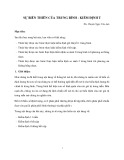
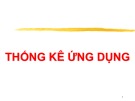
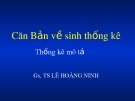
![Bài giảng Thống kê thực hành [Chuẩn SEO]](https://cdn.tailieu.vn/images/document/thumbnail/2015/20151118/codon_01/135x160/4141447817381.jpg)



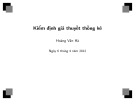
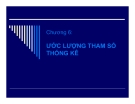




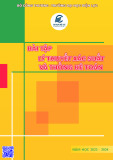










![Quyển ghi Xác suất và Thống kê [chuẩn nhất]](https://cdn.tailieu.vn/images/document/thumbnail/2025/20251030/anh26012006/135x160/68811762164229.jpg)
